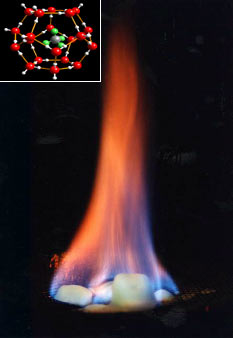

In addition to the well-known energy sources (coal, natural gas, etc.), there exist unconventional energy sources that have generated much interest in recent years. These include oil sands and oil shale, as well as methane hydrates. These unconventional energy sources have high environmental risks and are currently relatively expensive. Oil sands have been included in the oil reserves and oil resources since 2002, and oil shale is considered part of the oil resources. Even though it is probably a large fossil energy source, methane hydrates have not been considered in reported energy resources until 2012. Nevertheless, some reports have claimed that the expected quantities of carbon in methane hydrates contain twice the quantities of carbon as in coal, oil and natural gas combined.
The BGR Energy Study 2019 estimates the gas hydrate world resource with 184 tcm (tera cubic meter).
Methane is formed in the ocean by bacteria, which transform dissolved carbon dioxide to methane or break down other biomaterial from the sea. To form methane hydrates, the water must be supersaturated with gas under certain pressure and temperature conditions. Low temperatures and high pressures are also necessary for the stability of methane hydrates. If the stability conditions are destroyed by environmental changes, large quantities of methane can be released. In this case, the methane will rise in the water, producing a huge greenhouse effect, as methane has 25 times the greenhouse effect of carbon dioxide.

The picture to the left shows white methane hydrates, which are burning with a red-yellow flame. Due to the burning, water drips down and carbon dioxide is produced. The inset above is a model of a methane hydrate cage.
The unit cell of the cubic crystal structure consists of eight ice cages, in which the water molecules (red oxygen atoms and white hydrogen atoms) are connected to each other by hydrogen bonds. Every ice cage contains one methane molecule. The stoichiometric formula is 8 CH4 46 H2O and the density is about 0.9 g/cm3.
Some countries have begun research programs to study possible generation of energy from methane hydrates but have not reached commercial production. As part of the Japanese government program MH21, the second test in June 2017 produced a volume of 222,500 m3 of methane within 24 days at a depth of about 1,000 m. The MH21 project will continue in 2025 and plans for further tests for offshore production in Japanese waters. In China, a test production of 300,000 m3 was carried out from May to July 2017 at a depth of 1266 m in the South China Sea near the Chinese coast. A publication reports on progress in the safety control of the production process.